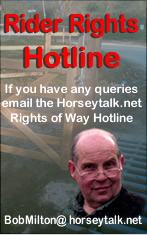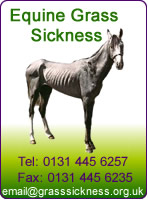
RIDER RIGHTS
Says Naomi Smith
 It is all too possible to round a corner on horseback
and come upon a group of cattle with no prior warning -this WILL result in
a horse being badly spooked at best, bolting at worst -it is only a matter of
time ........... read more
It is all too possible to round a corner on horseback
and come upon a group of cattle with no prior warning -this WILL result in
a horse being badly spooked at best, bolting at worst -it is only a matter of
time ........... read more
Meon Valley Trail. Cyclists should NOT be the focus
"The OS Explorer (119) shows long lengths of it as statutory bridleway and the rest permissive bridleway."
Says Maureen Comber
 Mike Turnbull asks how I can possibly say the principle user is equestrian? The answer is just by looking at the OS Explorer (119) which shows long lengths of it as statutory bridleway and the rest permissive bridleway.
Mike Turnbull asks how I can possibly say the principle user is equestrian? The answer is just by looking at the OS Explorer (119) which shows long lengths of it as statutory bridleway and the rest permissive bridleway.
Hampshire County Council will need to use statutory measures to upgrade the bridleways to restricted byways if they wish to include horse drawn vehicles. This would involve widespread consultation as would any change in the surface of the bridleways because equestrians have been the statutory principal users, as shown above.
I think most bridleways evolve from customary use of the roads and tracks long before there were motor vehicles. "Britains past has been born on his back. All our past is his industry"
If you really mean you would like to give more people access to the countryside then you will support my statement above with regard to the minor country lanes.
It is the predominant use of motor vehicles to all our roads and especially the unrestricted speed limit on the minor lanes which is disenfranchising cyclists and horse riders principally. Walkers are not so deprived as 80% of ROW are footpaths.
The historical rights on the trail
The background
Says Joanna Glyde
South Downs National Park Authority
 Rights of way were formalised in 1949 after the National Parks and Access to the Countryside Act. This was the point when access rights became formalised.
Rights of way were formalised in 1949 after the National Parks and Access to the Countryside Act. This was the point when access rights became formalised.
There are two definitive rights of way on the MVT. The first dates from the National Parks and Access to the Countryside Act and runs from Peake New Road to Stocks Lane and is 1.8 km long. The second dates from 1976 runs from near Moor Town Farm (just south of Droxford) to the end of the trail just north of Knowle village and is 10.2 km long.
The other two sections of the trail have, until now, only been legally permissive. This means that people are currently allowed to use it but that this permission could be removed by the land owner at any time. These permissive sections run for 2.2km stretch from Peake New Road to West Meon and the section from Droxford to Stocks Lane which is 3.8km.
To protect the long-term rights of the public to enjoy the full trail Hampshire County Council originally planned to formalise the entire trail to be a definitive bridleway. However, during the consultation, evidence was brought forward to show that there had also been permissive use for horse and carriages and for this reason this section will now be dedicated as a restricted byway.
The insurance implications
The trail owners would not be liable in the event of a conflict between different users.
Says Joanna Glyde
South Downs National Park Authority
 We expect everyone using the trail, whether cyclists, horse riders, walkers, wheelchair users disabled cyclists, to show respect to other users and use their own best judgement about safe and appropriate speeds to travel. The trail owners would not be liable in the event of a conflict between different users.
We expect everyone using the trail, whether cyclists, horse riders, walkers, wheelchair users disabled cyclists, to show respect to other users and use their own best judgement about safe and appropriate speeds to travel. The trail owners would not be liable in the event of a conflict between different users.
Tony Barnett comments
"The trail was a railway line, has there been a change of use registered, and who is the owner of the land, was it handed or sold back to the the original vendor or the now owner, there is not enough information"
Says Tony Barnett
 The 1949 chapter's 97,12,13,and 14 Geo 6 National parks and access to the countryside act, Is an act to make provision for national parks and the establishment of a national park's Commission; to confer on the nature conservancy and local authorities power for the establishment and maintenance of nature reserves; to make further provisions for the recording, creation, maintenance and approvement of public paths and for securing access to open countryside and to amend the law relating to rights of way, to confer further powers for preserving and enhancing natural beauty, and for matters connected with the purposes aforesaid.
The 1949 chapter's 97,12,13,and 14 Geo 6 National parks and access to the countryside act, Is an act to make provision for national parks and the establishment of a national park's Commission; to confer on the nature conservancy and local authorities power for the establishment and maintenance of nature reserves; to make further provisions for the recording, creation, maintenance and approvement of public paths and for securing access to open countryside and to amend the law relating to rights of way, to confer further powers for preserving and enhancing natural beauty, and for matters connected with the purposes aforesaid.
The path is from tarmac road shavings to include other hard standing material, even rolled in it will not prevent damage from use, it will not bind in and will flow to make embankments from use, this trail is being used as a cheap disposal of such steel road trimmings which does include flint.
Another statement needs examining and that is do trail users need to be insured, not as much as the council and national parks do, they are inviting and assuring safety, they have developed the trail, years in ground work has taught me that once the clerk of works has had the works signed over, there can be no come back, so safety is now the councils liability, it was upto them to see that the spec was complied with, who accepted or who will? no one will put their signature to it,but any accident, then the council and parks are liable,
One more interesting point, the trail was a railway line, has there been a change of use registered, and who is the owner of the land, was it handed or sold back to the the original vendor or the now owner, there is not enough information, I see that central government are paying for the works, is this from HMRC or Natural England?
Says Linda Wright
 We moved to a Shropshire location a year ago having surveyed the local OS
map and noted the significant number of bridleways around the property.
Sadly the map appears a total fiction. Scarce any of the bridleways are
usable ........... read more
We moved to a Shropshire location a year ago having surveyed the local OS
map and noted the significant number of bridleways around the property.
Sadly the map appears a total fiction. Scarce any of the bridleways are
usable ........... read more




